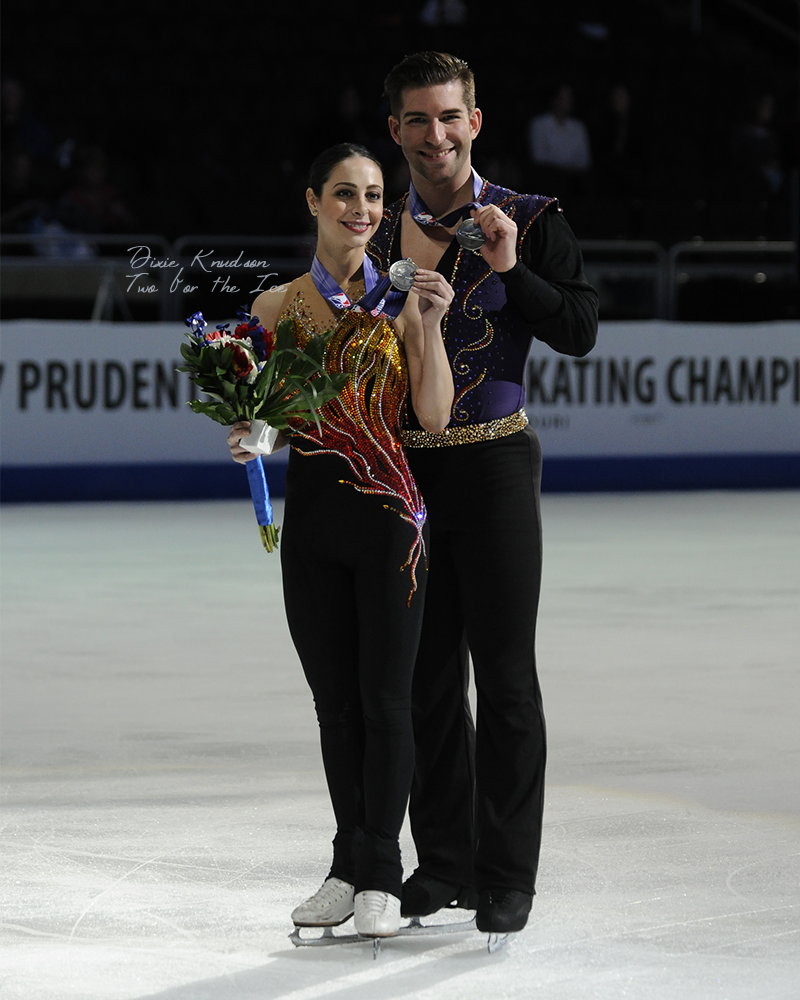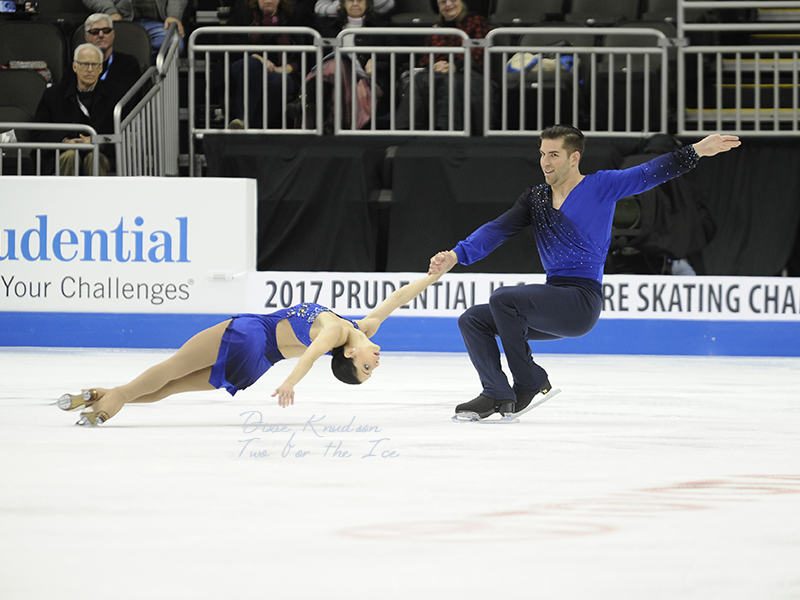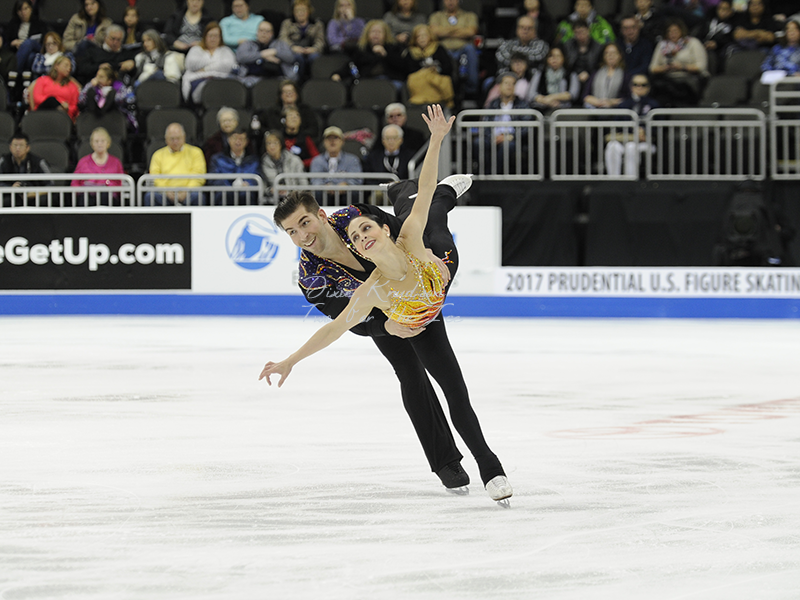by Jacquelyn Thayer
What might be overachievement for many new pairs — third in the short and fourth overall at their debut Nationals — is, for Deanna Stellato and Nate Bartholomay, a bit more like a storybook accomplishment.

Stellato and Bartholomay with their pewter medals at the 2017 U.S. Figure Skating Championships. Photo by Dixie Knudson.
So following the quick successes of last season, this year they’ve upgraded technically, working — with some demonstrable success already — to add side-by-side triple lutzes in both programs and a throw quad salchow in the free. But an equal priority has been boosting the Grades of Execution on their pair-specific elements.
“We’ve been catching the triple twist really consistently, making it bigger,” said Bartholomay. “With all the lifts, just trying to make them smooth and easy.”
While the lutz can rely on Stellato’s muscle memory, the two have utilized off-ice exercises to bolster the twist. And for the quad throw? “I would say the secret to the quad is butt pads — lots and lots of butt pads,” she said with a laugh. “Otherwise, it wasn’t so bad. I mean, it’s not that different for me from the triple — the takeoffs all feel the same, so it’s just a matter of pulling in tighter and figuring out where I’m at in the air.”
“It was also really important for us when we first started working on the quad, we really kind of slowed it down and really picked apart the triple in the harness,” added Bartholomay. “So that was a huge piece of our success. Now we don’t really use the harness anymore ever because we put that work in and put that time in. When you start doing these throw quads, it’s almost more than just a regular quad jump because it’s a little more dangerous — there’s a little more force behind it, it’s maybe a little bit bigger. So you really have to respect the element. But we’ve kind of put our time in and paid our dues, so now even if we have falls on it, they’re pretty easy and for the most part, we have pretty good success with it.”
After last season’s hurried start, the team has had an early opportunity to begin putting their new development to the test. They kicked off their season in the first week of July at local club event Orange Blossom Open, and the pace of the schedule hasn’t eased from there: next came a flawed but decent showing at the larger Skate Detroit, where they ranked second in both segments, and next it’s onto the Philadelphia Summer Championships in Bartholomay’s home state. They hope to follow that with some international assignments, perhaps even the TBA spot at Grand Prix event Skate America. But while Bartholomay is one of only two skaters in the current U.S. pairs field to have Olympic experience — the other, Marissa Castelli, now skates with Mervin Tran, who as a Canadian citizen is currently ineligible to represent the U.S. in Pyeongchang — it’s not specific placements focusing their drive this year.
“For us this year, and in the past for me, it worked really well to just have our own personal performance goals,” said Bartholomay — the quad throw and lutzes taking particular precedent. “They’re in both programs every day, so we’re really focused on how to have them down and perform the way that we know we can perform. And then as far as goals, you know, obviously we want to peak at Nationals and do really well and improve on our result last year. But as far as ranking ourselves or anything after that, we’re not too focused on that, specifically because you really can’t be focused on that this season especially.”

Stellato and Bartholomay perform in the short program at the 2017 U.S. Figure Skating Championships. Photo by Dixie Knudson.
Ward and Pillay watched the pair’s Nationals performances to devise their initial program ideas. From there, the team worked with each man to make the final calls: with Ward, a semi-instrumental cover of “Eleanor Rigby” featuring violinist Joshua Bell, and with Pillay, a stripped-down cover of U2’s “One” along with the band’s original “Where the Streets Have No Name” — a set of songs proving a contrast to last season’s more traditional “Firebird” free, which arose from the choreography assembled as a senior pairs test program for Stellato.
Ward traveled to Florida for a few days of initial program choreography, and after a trip to Colorado Springs for June’s U.S. pairs camp, the two took a detour to his 7k Skating Academy in Monument for additional tweaks and touch-ups. With Pillay, the team worked at his Vancouver base, which offered a prime environment for program creation. “We ended up using private ice, nothing going on, and just focused, and he was just in his element,” said Bartholomay. “You know, you didn’t have to worry about traveling or anything.”
If the rock-based selections build on the success of last year’s “Hallelujah” short, they hold a particular thrill for the veteran Stellato. “I really can get into both songs,” she said. “You know, when I skated before, there were no words — it’s so nice to be able to skate with words. So this is really exciting for me because I really enjoy both of our programs and both [pieces of] music, and I look forward to hearing it on our practice sessions. It’s nice to not hear the same rigamarole of instrumental music that I used to, you know, in 1999.”
A return to the stage also means new observations, as Stellato has found value in closely watching those more established international pairs on today’s scene.

Stellato and Bartholomay perform in the long program at the 2017 U.S. Figure Skating Championships. Photo by Dixie Knudson.
Other exemplars include two-time world champions Meagan Duhamel and Eric Radford — “I think Meagan is such a tough, strong pair girl,” she noted — along with this year’s world podium couples and France’s rising Vanessa James and Morgan Cipres. “I watch all of them for simple things, for stroking and their in-between skating as well as for their big trick elements.”
And just as learning takes on new meaning with maturity, Stellato, despite the 15-year layoff since the first phase of her competitive career, has also found the physical demands almost easier to manage than in her junior days, when she battled hip and ankle injury.
“It’s just a matter of managing little aches and pains and then doing what I need to do afterwards to fix that ache or that pain, which I’m probably better at as an adult than I was as a kid,” she said. “So, you know, rolling out, taking Epsom salt baths, going to the chiropractor — whatever it is that I need to do to properly recover my body, I’m probably more proficient at now than I was when I was a teenager.”
Bartholomay credits consistency and concentration, more than work on any specific element, as the pair’s biggest training success so far — a regimen focused on regular run-throughs, warm up and stretch routines, and even what he calls “almost a choreographed cool down.” Though it may have helped as a form of injury prevention, it’s also reinforced by the pair’s good conditioning.
“If you have two healthy athletes, you can just push and pound a little bit more,” he said. “Other than aches and pains and sore muscles, which are a given in this sport, if you set yourself up with two healthy bodies, you can really maximize on your potential every day.”
And the ultimate aims of that maximization are simple enough. “We really look forward to showing everyone what we have when we feel like we’ve improved a lot over these past six months from Nationals to now,” said Stellato.
The aforementioned U.S. pairs camp was no new experience for Bartholomay, a veteran of the discipline — but for his partner, it was, as she joked, something like “Baby’s first pair camp.”
“It was so cool to work with these people that you see on TV, you know, like Nina Mozer and Robin [Szolkowy],” she said. “Honestly, we had the best time. There were so many things that we took away from that camp. It wasn’t just like, well, we’ve been here for a week and we took one great little piece of something — it was like, no, every day there were multiple things that we were like, oh my gosh. Oh my goodness, this is amazing. So it was awesome. I really can’t stress enough how great of a time I had and how much we learned, and I think how much we’ve even improved just from the pearls of wisdom that we’ve gotten that week.”
And it was far from big tricks taking center stage. “There wasn’t one session that we did where we didn’t start it off with 15 to 20 minutes of just stroking exercises and tracking and things like that,” said Stellato. “It is absolute basics of figure skating. It’s just beautiful, nice stroking and it’s what they focus on it sounds like every day at their camp at home. Literally on every session, we had 20 minutes of that before we were even allowed to do a single jump, throw, twist or anything.”
Stellato credits diet — one low in sugar, free of dairy, and leaning towards the vegan — as another key to her comeback success. “I’ve been kind of slowly trying to wean myself off of certain things, just for recovery, and I’ve watched a bunch of documentaries saying thing that an anti-inflammatory diet is what’s best, you know, for life, certainly, but certainly for an athlete even more,” she said. “So I try to be relatively strict with myself in that regard and the more that I kind of look into it and research it, the more that there’s available for it, the more that I realize there are so many foods and things that are out there that are dairy-free, soy-free, gluten-free, all that kind of stuff. So I try to follow that type of a plan and then maybe have like a day out of the week where I’ll cheat or something like, like a one cheat meal. But for the most part during the week, I’m pretty strict.”
Both skaters also log considerable hours in the rink coaching, and while Stellato uses her rare downtime to relax and try out new recipes, Bartholomay’s now making a special commitment to his personal time. “I’m usually pretty busy and when I’m not at the rink, I just take every opportunity I get to kind of relax and play with my dog,” he said. With a laugh, he continued, “I realized a couple of years ago that I’ve been living in Florida for about six years and I’ve been to the beach like four times. So this year especially, I’ve been trying to just go — even if it’s just for like a half hour walk — to the beach every weekend.”
